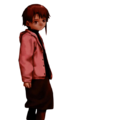
The official discord link if you wish to join the discord: https://discord.gg/j5RKwCvAFu
Support the wiki on our official Ko-Fi page or Patreon page!
Serial Experiments Lain
From The Codex
Background
Serial Experiments Lain is a Japanese anime series directed by Ryuutarou Nakamura, with character designs by Yoshitoshi ABe, a screenplay by Chiaki J. Konaka, and produced by Yasuyuki Ueda (credited as "production 2nd") for the animation studio Triangle Staff. The show aired on TV Tokyo between July and September 1998 and consists of 13 episodes. A companion PlayStation game, also titled Serial Experiments Lain, was released by Pioneer LDC in November of the same year.
The series touches on philosophical themes like the nature of reality, identity, and human communication. It centers on Lain Iwakura, a teenage girl living with her family in suburban Japan.
In North America, Serial Experiments Lain was first licensed by Geneon (formerly Pioneer Entertainment), which released the series on VHS, LaserDisc, and DVD. A high-definition Blu-ray version, with redone CG segments, was later released in Japan in 2009 and in the U.S. in 2012. Funimation acquired the license in 2010 and has continued to distribute the series. Outside of these regions, the anime was also made available in Singapore through Odex. The PlayStation game, which shares the same characters and some themes but takes a different approach to storytelling, was never officially released outside Japan.
Lain initially comes across as quiet and withdrawn, keeping to herself most of the time. Her family includes her emotionally distant mother Miho, her tech-obsessed father Yasuo, and her disinterested older sister Mika. Lain’s routine life begins to shift when she hears that a girl from her school, Chisa Yomoda, has committed suicide. Afterward, several classmates claim to have received an e-mail from Chisa, apparently sent after her death. When Lain checks her own device at home, she finds the same message. In it, Chisa insists she isn’t really dead, but has simply left behind her physical form and found God within the Wired—a vast, internet-like network. This strange encounter becomes Lain’s first step into a world of hidden layers, where the boundary between digital and physical reality starts to break down.
The anime explores how technology and consciousness can overlap, with Lain gradually uncovering her unique role in the development of the Wired. As the show continues, it introduces ideas related to collective memory, artificial intelligence, and the impact of virtual spaces on personal identity. Lain’s increasing involvement in the Wired also brings her into conflict with secretive groups and other individuals who see her as more than just a regular girl.
The anime has drawn from a range of influences, including philosophy, cyberpunk fiction, computer history, and conspiracy theories. These topics have made it a subject of interest for academic discussion and analysis. While many English-speaking reviewers described the series as confusing or surreal, the general critical response has been positive. Producer Ueda originally hoped that Western and Japanese viewers would interpret the show differently, but later noted that their reactions ended up being surprisingly similar.
The opening theme of the series is Duvet by the British band Bôa, and the ending theme is Tooi Sakebi, which complements the show’s quiet and haunting tone.Synopsis
General Information
Official Date
- Anime: July 6, 1998
- Video Game: November 26, 1998
- Manga: May 1999
- //signal.: April 30, 2025
Company
- Anime: Triangle Staff
- Video Game: Pioneer LDC
Creator
- Anime: Yasuyuki Ueda
- Video Game: Pioneer LDC
- Manga: Yoshitoshi Abe
- //signal.: Team MJM
Genre: Cyberpunk, Psychological horror,Techno-horror
Cosmology: Multiverse (There is a border between the Wired and the real world which is eventually destroyed by Lain[1], where the Wired acts as another world being created separate from the real world[2])
Number of Series: 4 (The main anime, the PS1 video game, a short one-shot manga, and an upcoming game)
Number of
- Episodes: 13
- Games: 2
- Chapters: 1
Status: Ongoing (Lain is still receiving content even in current time, with an upcoming game called "//signal.")
Reception: Well Received (The anime is a cult classic that serves as an inspiration for many other authors series. It was awarded an Excellence Prize by the 1988 Japan Media Arts Festival for "its willingness to question the meaning of contemporary life" and the "extraordinarly philosophical and deep questions" it asks)
List of Misconceptions
Lain's friend being named "Arisu"
Some subs take names pronounciation of Alice's name as exactly how her name is spelled, calling her "Arisu", however this is just a japanese-accent of saying the name "Alice" as r and l are the same in Japan.
The Wired is an Upper Layer of the Real World
This belief comes from Layer 05: Distortion where Masami Eiri in the form of Lain's mom, Miho Iwakura, explains to Lain that is is reasonable to see the Wired as an upper layer of the real world[3].
However Lain once having full control later in the series reveals the Wired is not an upper layer of the real world[4], reconfirming it to herself in Layer 13: "Ego"[5].
Lain's effects only work under those put under Protcol Seven
This belief comes from the explanation given for how Masami Eiri created Proctol Seven, where all humans were plugged in at the unconscious level without the need for any device, encoding the Schumann Resonance Factor and inserting it into the 7th-gen Wired Protocol[6], however, this does not mean one that doesn't follow Schumann's Resonance Factor or isn't under Protocol Seven would be unaffected.
The Schumann Resonance is based off the idea that Earth has its own specific electromagnetic waves, between the ionosphere and the Earth's surface, there is constant resonance at a frequency of 8Hz in the ELF band, giving these "Earth Brain Waves" to humanity, attempting to awaken the concsiousness of the Earth itself through networking all humans[7], so as long as one has any form of electromagnetic waves, they would be affected by this, though it extends even further. Lains powers allow herto turn something that did happen into something that didn't[8], completely destroyed the boundary between the Wired and the real world, allowing her to completely undo events that occured[9], events are abstract, non-physical pieces that would not be bound by electromagnetism, yet Lain is still completely able to influence them.
Furthermore, even after Lain reset the world and caused herself to never exist[10], she still existed within the Wired and could later manifest into the real world despite never existing[11], still having full control and being able to use her powers, this should be something impossible as Eiri Masami was made to have never made her or Protocol Seven, thus it shouldn't exist.
Power of the Verse
Lain mainly has regular human entities within the series, though it carries some supernatural elements such as programs like KIDS, which takes the latent psychic energy within children and tries to combine it.
Lain herself is a cosmic entity, being able to fully control reality as she sees fit. Eiri Masami to a lesser extent has some influence over the real world.
The verse has abilities such as: Reality Warping, Information Manipulation, Data Manipulation, Causality Manipulation, Memory Manipulation, Space-Time Manipulation, etcetera.
Explanations
File Systems
The game’s interface resembles a database known as "life instinct function" (LIF), hosted on a server at Tachibana General Laboratories. This database is divided into two sections: Site A and Site B. Site B is initially locked and can only be accessed by unlocking hidden updates in the files. Each file contains a version number that must match or exceed the version of the player's media player to be accessed. The player can find updates within the files to upgrade the media player.
Various file types are stored within the database, including:
- Lda: A collection of 237 diary entries written by Lain over three years, detailing her personal feelings, given to her by Touko early in their counseling sessions.
- Tda: A series of 92 diary entries by Touko, spanning two years.
- Cou: A series of 53 counseling session recordings between Lain and Touko, with roles reversing as Touko becomes unstable.
- Dia: A set of 48 diagnoses by Lain and Touko regarding their patient's behavior and recommended actions. Lain's entries are labeled "CLN_00," while Touko’s are labeled "CLN_01."
- TaK: 181 random statements or questions recorded by Lain and Touko, presented in two parallel chronologies.
- Ekm: 6 recordings of conversations between Lain and her friend Kyoko, labeled "Extra Kyoko’s Memory" and only available on Site A.
- Ere: 10 interviews with Lain's classmates conducted by Touko, called "Extra Research" and found on Site B.
- Eda: A mix of 4 counseling sessions and a news report, labeled "Extra Data," and located on Site B.
- Sskn: 7 freeware upgrade apps for the media player, unlocking more content.
- P2-: Parts for a virtual bear model, Poly-tan, that unlock new files when completed.
- GaTE: 4 network applications needed to unlock Site B from Site A.
- Dc1: 57 animated video files, mostly of Lain, presented in random order across Site A and B. Some are unusual, like hidden camera footage or impossible shots, and are labeled "Dcl."
- Env: 12 corrupted files filled with static and voices, found on Site A’s Level 0.
- Xv0 and Xa': Extra unused video clips and audio files, mostly featuring Touko in distress, not part of the main game.
Knowledgeable Members
Characters
References
- ↑ Serial Experiments Lain Layer 11: "Infornography"
- ↑ Serial Experiments Lain Layer 05: "Distortion"
- ↑ Serial Experiemnts Lain Layer 05: "Distortion"
- ↑ Serial Experiments Lain Layer 12: "Landscape"
- ↑ Serial Experiments Lain Layer 13: "Ego"
- ↑ Serial Experiments Lain Layer 09: "Protocol"
- ↑ Serial Experiments Lain Layer 09: "Protocol"
- ↑ Serial Experiments Lain Layer 09: "Protocol"
- ↑ Serial Experiemnts Lain Layer 11: "Infornography"
- ↑ Serial Experiments Lain Layer 13: "Ego"
- ↑ Serial Experiments Lain Layer 13: "Ego"




